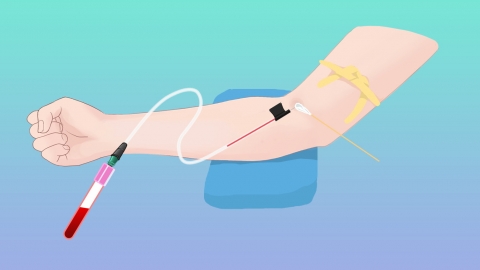What causes a lump after venipuncture?
Bruising or swelling after venous blood draw may result from improper puncture technique, incorrect compression method, local hematoma, phlebitis, or abnormal coagulation function. It can be managed through proper compression, local care, and medication. If the swelling continues to enlarge or is accompanied by severe pain, fever, or other symptoms, prompt medical attention is required.

1. Improper puncture technique: During blood collection, if the needle fails to fully enter the vessel or penetrates through the vessel wall, blood may leak into the subcutaneous tissue, causing localized swelling, which might be associated with mild soreness. It is recommended to immediately apply sterile gauze along the direction of the blood vessel to compress the puncture site and surrounding area after blood draw, maintaining pressure for 5–10 minutes without rubbing.
2. Incorrect compression method: Insufficient pressure, too short a duration, or frequent shifting during compression after blood draw may allow blood to seep out from the puncture site, leading to swelling, and in some individuals, the skin over the swelling may darken. It is advised to use the fingertip pad to apply vertical pressure, ensuring complete coverage of the puncture site, while keeping the arm straight and minimizing movement during compression.
3. Local hematoma: Incomplete hemostasis at the site of vascular injury after blood draw can lead to continuous accumulation of blood under the skin, forming a hematoma. This presents as localized swelling and tenderness, with possible bluish-purple or reddish discoloration of the skin. Patients may use medications such as mucopolysaccharide polysulfate cream, heparin sodium cream, or diclofenac diethylamine gel under medical guidance to relieve symptoms.
4. Phlebitis: Inflammation of the vein may occur due to catheter irritation during blood draw or inadequate disinfection at the puncture site. The inflammation causes local vasodilation and fluid leakage, resulting in swelling, redness, and pain along the course of the vein. Under medical supervision, treatments may include magnesium sulfate injection, domperidone tablets, or ibuprofen sustained-release capsules to alleviate symptoms.
5. Coagulation dysfunction: Deficiency in clotting factors or reduced platelet count impairs blood clotting after venipuncture, making subcutaneous bleeding and swelling more likely. This may also be accompanied by symptoms such as gum bleeding or skin bruising. Treatment may involve medications such as vitamin K1 injection, tranexamic acid tablets, or etamsylate injection, used as directed by a physician.
For daily care, keep the puncture site clean and dry, avoiding contact with water for 24 hours. Apply cold compresses early to minimize bleeding, followed by warm compresses later to promote absorption. Avoid pressing on the swollen area and wear loose clothing to reduce local friction.




